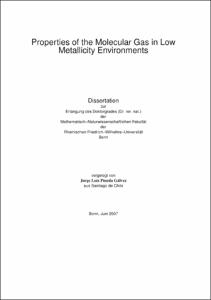Properties of the Molecular Gas in Low Metallicity Environments

Properties of the Molecular Gas in Low Metallicity Environments

| dc.contributor.advisor | Klein, Ulrich | |
| dc.contributor.author | Pineda Gálvez, Jorge Luis | |
| dc.date.accessioned | 2020-04-10T16:29:29Z | |
| dc.date.available | 2020-04-10T16:29:29Z | |
| dc.date.issued | 2007 | |
| dc.identifier.uri | https://hdl.handle.net/20.500.11811/3114 | |
| dc.description.abstract | Understanding star formation is of great importance in modern astrophysics because it gives us crucial information on the way galaxies evolve and therefore provides important insights into the evolution and nature of our Universe. Times scales, efficiency, and the rate at which star formation occurs are determined by the physical and chemical properties of the molecular gas at different scales. The processes of star formation occur in dense molecular gas. Determinant properties of this gas are the abundance of heavy elements (metallicity) and the relative amount of dust (dust-to-gas ratio). Both quantities evolve during the lifetime of our Universe. Therefore, in order to understand the processes of star formation in the earlier stages of our Universe, we need to know the form and extent on which these quantities affect the properties of the gas that form stars. In this thesis we study the properties of the molecular gas in low-metallicity environments. Considering that in the low-metallicity molecular gas most of the millimeter and sub-millimeter emission comes from photon-dominated regions (PDRs), we approach our study in their context. For that, we utilize a spherically symmetric PDR model. We first calibrate the PDR model in the weak far-ultraviolet radiation field regime studying the pre-stellar core Barnard 68. Owing to its roughly spherical morphology and well-constrained density profile, Barnard 68 is ideal for such study. We later analyze the case when the low-metallicity gas is exposed to weak FUV radiation fields. This is the case of intermediate velocity clouds (IVCs). We then investigate global properties of the metal-poor molecular gas exposed to stronger FUV radiation fields using large scale observations of the 30 Dor molecular ridge in the Large Magellanic Cloud (LMC). We later use a PDR model to investigate the nature of the millimeter and sub-millimeter emission emerging from the N159W region. We finally study the variations of line ratios involving [CII], [CI, 12CO, and 13CO transitions as a function of the strength of the FUV radiation field. A better understanding of the properties of the low metallicity gas in local examples will serve as a template for future studies of the ISM in galaxies at high redshift using ALMA. | en |
| dc.language.iso | eng | |
| dc.rights | In Copyright | |
| dc.rights.uri | http://rightsstatements.org/vocab/InC/1.0/ | |
| dc.subject.ddc | 520 Astronomie, Kartografie | |
| dc.title | Properties of the Molecular Gas in Low Metallicity Environments | |
| dc.type | Dissertation oder Habilitation | |
| dc.publisher.name | Universitäts- und Landesbibliothek Bonn | |
| dc.publisher.location | Bonn | |
| dc.rights.accessRights | openAccess | |
| dc.identifier.urn | https://nbn-resolving.org/urn:nbn:de:hbz:5N-11087 | |
| ulbbn.pubtype | Erstveröffentlichung | |
| ulbbnediss.affiliation.name | Rheinische Friedrich-Wilhelms-Universität Bonn | |
| ulbbnediss.affiliation.location | Bonn | |
| ulbbnediss.thesis.level | Dissertation | |
| ulbbnediss.dissID | 1108 | |
| ulbbnediss.date.accepted | 19.06.2007 | |
| ulbbnediss.fakultaet | Mathematisch-Naturwissenschaftliche Fakultät | |
| dc.contributor.coReferee | Krügel, Endrik |
Files in this item
This item appears in the following Collection(s)
-
E-Dissertationen (4397)




